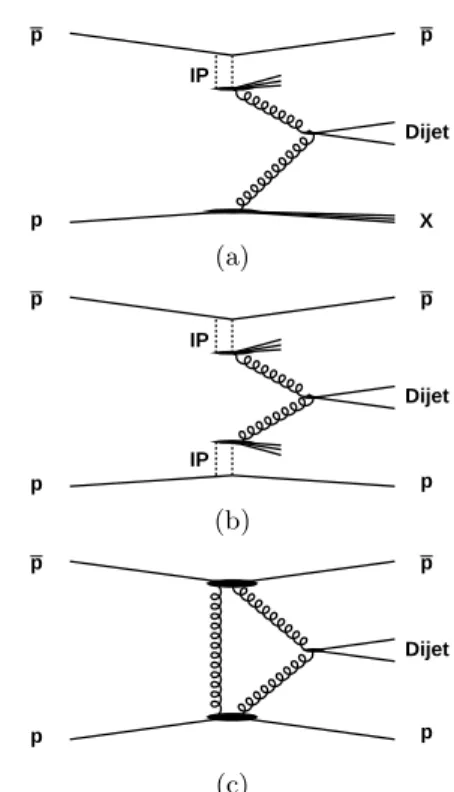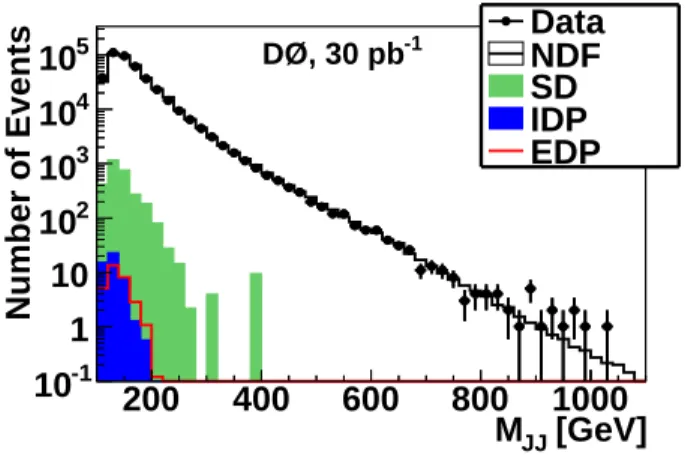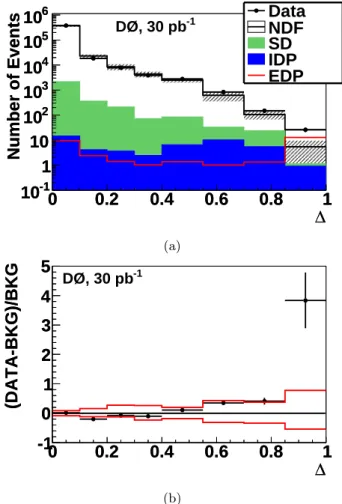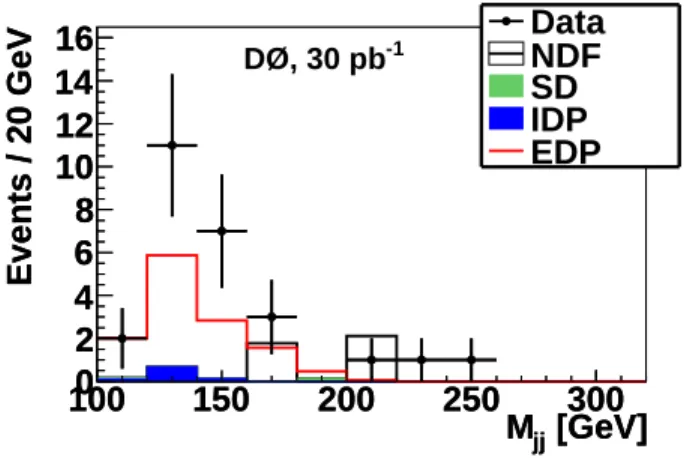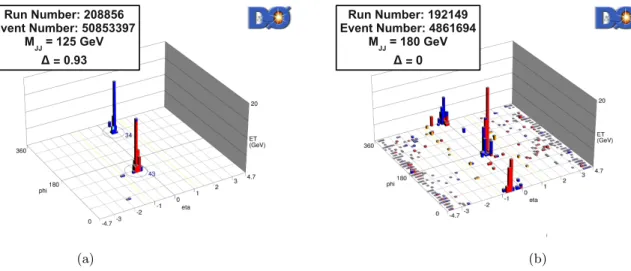arXiv:1009.2444v1 [hep-ex] 13 Sep 2010
High mass exclusive diffractive dijet production in p¯
p collisions at
√
s = 1.96 TeV
V.M. Abazov,35 B. Abbott,73 M. Abolins,62 B.S. Acharya,29 M. Adams,48 T. Adams,46 G.D. Alexeev,35 G. Alkhazov,39A. Altona,61G. Alverson,60 G.A. Alves,2 L.S. Ancu,34 M. Aoki,47 Y. Arnoud,14 M. Arov,57 A. Askew,46 B. ˚Asman,40 O. Atramentov,65C. Avila,8 J. BackusMayes,80F. Badaud,13L. Bagby,47B. Baldin,47
D.V. Bandurin,46 S. Banerjee,29 E. Barberis,60 P. Baringer,55 J. Barreto,2 J.F. Bartlett,47 U. Bassler,18 V. Bazterra,48 S. Beale,6 A. Bean,55 M. Begalli,3 M. Begel,71 C. Belanger-Champagne,40L. Bellantoni,47 S.B. Beri,27 G. Bernardi,17 R. Bernhard,22 I. Bertram,41M. Besan¸con,18 R. Beuselinck,42 V.A. Bezzubov,38 P.C. Bhat,47 V. Bhatnagar,27 G. Blazey,49 S. Blessing,46K. Bloom,64 A. Boehnlein,47 D. Boline,70 T.A. Bolton,56
E.E. Boos,37G. Borissov,41T. Bose,59 A. Brandt,76 O. Brandt,23 R. Brock,62 G. Brooijmans,68 A. Bross,47 D. Brown,17 J. Brown,17X.B. Bu,7 D. Buchholz,50M. Buehler,79 V. Buescher,24 V. Bunichev,37 S. Burdinb,41 T.H. Burnett,80 C.P. Buszello,42B. Calpas,15E. Camacho-P´erez,32M.A. Carrasco-Lizarraga,32B.C.K. Casey,47
H. Castilla-Valdez,32 S. Chakrabarti,70 D. Chakraborty,49 K.M. Chan,53 A. Chandra,78 G. Chen,55 S. Chevalier-Th´ery,18 D.K. Cho,75 S.W. Cho,31 S. Choi,31B. Choudhary,28 T. Christoudias,42 S. Cihangir,47 D. Claes,64 J. Clutter,55 M. Cooke,47 W.E. Cooper,47 M. Corcoran,78F. Couderc,18M.-C. Cousinou,15 A. Croc,18
D. Cutts,75 M. ´Cwiok,30A. Das,44 G. Davies,42 K. De,76 S.J. de Jong,34E. De La Cruz-Burelo,32 F. D´eliot,18 M. Demarteau,47 R. Demina,69 D. Denisov,47 S.P. Denisov,38 S. Desai,47 K. DeVaughan,64 H.T. Diehl,47 M. Diesburg,47 A. Dominguez,64 T. Dorland,80 A. Dubey,28 L.V. Dudko,37D. Duggan,65A. Duperrin,15 S. Dutt,27
A. Dyshkant,49 M. Eads,64 D. Edmunds,62 J. Ellison,45 V.D. Elvira,47 Y. Enari,17S. Eno,58 H. Evans,51 A. Evdokimov,71 V.N. Evdokimov,38G. Facini,60 T. Ferbel,58, 69 F. Fiedler,24 F. Filthaut,34 W. Fisher,62 H.E. Fisk,47 M. Fortner,49H. Fox,41 S. Fuess,47 T. Gadfort,71 A. Garcia-Bellido,69 V. Gavrilov,36P. Gay,13 W. Geist,19 W. Geng,15, 62 D. Gerbaudo,66 C.E. Gerber,48 Y. Gershtein,65G. Ginther,47, 69 G. Golovanov,35 A. Goussiou,80 P.D. Grannis,70 S. Greder,19 H. Greenlee,47 Z.D. Greenwood,57E.M. Gregores,4G. Grenier,20
Ph. Gris,13 J.-F. Grivaz,16 A. Grohsjean,18 S. Gr¨unendahl,47 M.W. Gr¨unewald,30 F. Guo,70 J. Guo,70 G. Gutierrez,47 P. Gutierrez,73 A. Haasc,68 S. Hagopian,46 J. Haley,60 L. Han,7 K. Harder,43A. Harel,69 J.M. Hauptman,54 J. Hays,42 T. Head,43 T. Hebbeker,21 D. Hedin,49H. Hegab,74 A.P. Heinson,45 U. Heintz,75
C. Hensel,23 I. Heredia-De La Cruz,32K. Herner,61 G. Hesketh,60 M.D. Hildreth,53 R. Hirosky,79 T. Hoang,46 J.D. Hobbs,70B. Hoeneisen,12 M. Hohlfeld,24 S. Hossain,73 Z. Hubacek,10N. Huske,17V. Hynek,10 I. Iashvili,67 R. Illingworth,47 A.S. Ito,47 S. Jabeen,75 M. Jaffr´e,16 S. Jain,67 D. Jamin,15R. Jesik,42 K. Johns,44 M. Johnson,47 D. Johnston,64A. Jonckheere,47P. Jonsson,42J. Joshi,27A. Justed,47 K. Kaadze,56 E. Kajfasz,15D. Karmanov,37
P.A. Kasper,47I. Katsanos,64R. Kehoe,77 S. Kermiche,15 N. Khalatyan,47A. Khanov,74 A. Kharchilava,67 Y.N. Kharzheev,35 D. Khatidze,75 M.H. Kirby,50 J.M. Kohli,27 A.V. Kozelov,38J. Kraus,62 A. Kumar,67 A. Kupco,11 T. Kurˇca,20 V.A. Kuzmin,37 J. Kvita,9 S. Lammers,51 G. Landsberg,75P. Lebrun,20 H.S. Lee,31 S.W. Lee,54W.M. Lee,47J. Lellouch,17L. Li,45Q.Z. Li,47 S.M. Lietti,5 J.K. Lim,31 D. Lincoln,47J. Linnemann,62
V.V. Lipaev,38 R. Lipton,47 Y. Liu,7 Z. Liu,6 A. Lobodenko,39M. Lokajicek,11 P. Love,41 H.J. Lubatti,80 R. Luna-Garciae,32 A.L. Lyon,47 A.K.A. Maciel,2 D. Mackin,78R. Madar,18 R. Maga˜na-Villalba,32 S. Malik,64
V.L. Malyshev,35Y. Maravin,56 J. Mart´ınez-Ortega,32 R. McCarthy,70 C.L. McGivern,55 M.M. Meijer,34 A. Melnitchouk,63 D. Menezes,49 P.G. Mercadante,4 M. Merkin,37 A. Meyer,21J. Meyer,23 N.K. Mondal,29
G.S. Muanza,15 M. Mulhearn,79 E. Nagy,15 M. Naimuddin,28 M. Narain,75 R. Nayyar,28 H.A. Neal,61 J.P. Negret,8 P. Neustroev,39 S.F. Novaes,5 T. Nunnemann,25 G. Obrant,39 J. Orduna,32 N. Osman,42 J. Osta,53 G.J. Otero y Garz´on,1 M. Owen,43 M. Padilla,45 M. Pangilinan,75 N. Parashar,52 V. Parihar,75 S.K. Park,31J. Parsons,68R. Partridgec,75 N. Parua,51A. Patwa,71B. Penning,47M. Perfilov,37 K. Peters,43
Y. Peters,43 G. Petrillo,69 P. P´etroff,16 R. Piegaia,1 J. Piper,62 M.-A. Pleier,71 P.L.M. Podesta-Lermaf,32 V.M. Podstavkov,47 M.-E. Pol,2 P. Polozov,36 A.V. Popov,38 M. Prewitt,78 D. Price,51 S. Protopopescu,71 J. Qian,61A. Quadt,23 B. Quinn,63 M.S. Rangel,2K. Ranjan,28 P.N. Ratoff,41 I. Razumov,38 P. Renkel,77 P. Rich,43 M. Rijssenbeek,70 I. Ripp-Baudot,19 F. Rizatdinova,74 M. Rominsky,47 C. Royon,18 P. Rubinov,47 R. Ruchti,53 G. Safronov,36 G. Sajot,14A. S´anchez-Hern´andez,32M.P. Sanders,25B. Sanghi,47A.S. Santos,5 G. Savage,47L. Sawyer,57 T. Scanlon,42 R.D. Schamberger,70Y. Scheglov,39 H. Schellman,50 T. Schliephake,26 S. Schlobohm,80 C. Schwanenberger,43R. Schwienhorst,62 J. Sekaric,55 H. Severini,73 E. Shabalina,23 V. Shary,18
A.A. Shchukin,38 R.K. Shivpuri,28 V. Simak,10 V. Sirotenko,47 P. Skubic,73 P. Slattery,69 D. Smirnov,53 K.J. Smith,67 G.R. Snow,64 J. Snow,72 S. Snyder,71S. S¨oldner-Rembold,43L. Sonnenschein,21 A. Sopczak,41 M. Sosebee,76 K. Soustruznik,9B. Spurlock,76 J. Stark,14 V. Stolin,36 D.A. Stoyanova,38 E. Strauss,70M. Strauss,73
D. Strom,48 L. Stutte,47 P. Svoisky,73M. Takahashi,43 A. Tanasijczuk,1 W. Taylor,6M. Titov,18 V.V. Tokmenin,35 D. Tsybychev,70B. Tuchming,18C. Tully,66 P.M. Tuts,68L. Uvarov,39S. Uvarov,39S. Uzunyan,49R. Van Kooten,51 W.M. van Leeuwen,33N. Varelas,48E.W. Varnes,44I.A. Vasilyev,38P. Verdier,20L.S. Vertogradov,35M. Verzocchi,47 M. Vesterinen,43 D. Vilanova,18P. Vint,42 P. Vokac,10 H.D. Wahl,46 M.H.L.S. Wang,69J. Warchol,53 G. Watts,80
M. Wayne,53 M. Weberg,47 L. Welty-Rieger,50 M. Wetstein,58 A. White,76 D. Wicke,24 M.R.J. Williams,41 G.W. Wilson,55 S.J. Wimpenny,45 M. Wobisch,57 D.R. Wood,60T.R. Wyatt,43Y. Xie,47 C. Xu,61S. Yacoob,50
R. Yamada,47 W.-C. Yang,43 T. Yasuda,47 Y.A. Yatsunenko,35 Z. Ye,47 H. Yin,7 K. Yip,71 H.D. Yoo,75 S.W. Youn,47J. Yu,76 S. Zelitch,79 T. Zhao,80B. Zhou,61J. Zhu,61 M. Zielinski,69D. Zieminska,51and L. Zivkovic68
(The D0 Collaboration∗)
1Universidad de Buenos Aires, Buenos Aires, Argentina 2LAFEX, Centro Brasileiro de Pesquisas F´ısicas, Rio de Janeiro, Brazil
3Universidade do Estado do Rio de Janeiro, Rio de Janeiro, Brazil 4Universidade Federal do ABC, Santo Andr´e, Brazil
5Instituto de F´ısica Te´orica, Universidade Estadual Paulista, S˜ao Paulo, Brazil
6Simon Fraser University, Vancouver, British Columbia, and York University, Toronto, Ontario, Canada 7University of Science and Technology of China, Hefei, People’s Republic of China
8Universidad de los Andes, Bogot´a, Colombia 9Charles University, Faculty of Mathematics and Physics,
Center for Particle Physics, Prague, Czech Republic
10Czech Technical University in Prague, Prague, Czech Republic 11Center for Particle Physics, Institute of Physics,
Academy of Sciences of the Czech Republic, Prague, Czech Republic
12Universidad San Francisco de Quito, Quito, Ecuador 13LPC, Universit´e Blaise Pascal, CNRS/IN2P3, Clermont, France
14LPSC, Universit´e Joseph Fourier Grenoble 1, CNRS/IN2P3,
Institut National Polytechnique de Grenoble, Grenoble, France
15CPPM, Aix-Marseille Universit´e, CNRS/IN2P3, Marseille, France 16LAL, Universit´e Paris-Sud, CNRS/IN2P3, Orsay, France 17LPNHE, Universit´es Paris VI and VII, CNRS/IN2P3, Paris, France
18CEA, Irfu, SPP, Saclay, France
19IPHC, Universit´e de Strasbourg, CNRS/IN2P3, Strasbourg, France
20IPNL, Universit´e Lyon 1, CNRS/IN2P3, Villeurbanne, France and Universit´e de Lyon, Lyon, France 21III. Physikalisches Institut A, RWTH Aachen University, Aachen, Germany
22Physikalisches Institut, Universit¨at Freiburg, Freiburg, Germany
23II. Physikalisches Institut, Georg-August-Universit¨at G¨ottingen, G¨ottingen, Germany 24Institut f¨ur Physik, Universit¨at Mainz, Mainz, Germany
25Ludwig-Maximilians-Universit¨at M¨unchen, M¨unchen, Germany 26Fachbereich Physik, Bergische Universit¨at Wuppertal, Wuppertal, Germany
27Panjab University, Chandigarh, India 28Delhi University, Delhi, India
29Tata Institute of Fundamental Research, Mumbai, India 30University College Dublin, Dublin, Ireland
31Korea Detector Laboratory, Korea University, Seoul, Korea 32CINVESTAV, Mexico City, Mexico
33FOM-Institute NIKHEF and University of Amsterdam/NIKHEF, Amsterdam, The Netherlands 34Radboud University Nijmegen/NIKHEF, Nijmegen, The Netherlands
35Joint Institute for Nuclear Research, Dubna, Russia 36Institute for Theoretical and Experimental Physics, Moscow, Russia
37Moscow State University, Moscow, Russia 38Institute for High Energy Physics, Protvino, Russia 39Petersburg Nuclear Physics Institute, St. Petersburg, Russia 40Stockholm University, Stockholm and Uppsala University, Uppsala, Sweden
41Lancaster University, Lancaster LA1 4YB, United Kingdom 42Imperial College London, London SW7 2AZ, United Kingdom 43The University of Manchester, Manchester M13 9PL, United Kingdom
44University of Arizona, Tucson, Arizona 85721, USA 45University of California Riverside, Riverside, California 92521, USA
46Florida State University, Tallahassee, Florida 32306, USA 47Fermi National Accelerator Laboratory, Batavia, Illinois 60510, USA
48University of Illinois at Chicago, Chicago, Illinois 60607, USA 49Northern Illinois University, DeKalb, Illinois 60115, USA
50Northwestern University, Evanston, Illinois 60208, USA 51Indiana University, Bloomington, Indiana 47405, USA 52Purdue University Calumet, Hammond, Indiana 46323, USA 53University of Notre Dame, Notre Dame, Indiana 46556, USA
54Iowa State University, Ames, Iowa 50011, USA 55University of Kansas, Lawrence, Kansas 66045, USA 56Kansas State University, Manhattan, Kansas 66506, USA 57Louisiana Tech University, Ruston, Louisiana 71272, USA 58University of Maryland, College Park, Maryland 20742, USA
59Boston University, Boston, Massachusetts 02215, USA 60Northeastern University, Boston, Massachusetts 02115, USA
61University of Michigan, Ann Arbor, Michigan 48109, USA 62Michigan State University, East Lansing, Michigan 48824, USA
63University of Mississippi, University, Mississippi 38677, USA 64University of Nebraska, Lincoln, Nebraska 68588, USA 65Rutgers University, Piscataway, New Jersey 08855, USA 66Princeton University, Princeton, New Jersey 08544, USA 67State University of New York, Buffalo, New York 14260, USA
68Columbia University, New York, New York 10027, USA 69University of Rochester, Rochester, New York 14627, USA 70State University of New York, Stony Brook, New York 11794, USA
71Brookhaven National Laboratory, Upton, New York 11973, USA 72Langston University, Langston, Oklahoma 73050, USA 73University of Oklahoma, Norman, Oklahoma 73019, USA 74Oklahoma State University, Stillwater, Oklahoma 74078, USA
75Brown University, Providence, Rhode Island 02912, USA 76University of Texas, Arlington, Texas 76019, USA 77Southern Methodist University, Dallas, Texas 75275, USA
78Rice University, Houston, Texas 77005, USA 79University of Virginia, Charlottesville, Virginia 22901, USA
80University of Washington, Seattle, Washington 98195, USA
(Dated: September 13, 2010)
We present evidence for diffractive exclusive dijet production with an invariant dijet mass greater than 100 GeV in data collected with the D0 experiment at the Fermilab Tevatron Collider. A discriminant based on calorimeter information is used to measure a significant number of events with little energy (typically less than 10 GeV) outside the dijet system, consistent with the diffractive exclusive dijet production topology. The probability for these events to be explained by other dijet production processes is 2 × 10−5, corresponding to a 4.1 standard deviation significance.
PACS numbers: 12.38.Qk, 24.10.Ht, 13.87.Ce, 12.40.Nn
Hard diffraction was first observed about twenty years ago in the UA8 experiment at the CERN p¯p collider SPS [1] and has been studied extensively in several exper-iments: H1 and ZEUS at the DESY ep Collider HERA [2] and D0 and CDF at the Fermilab Tevatron [3]. At hadron colliders, hard diffractive events are identified by the sig-nature of a hard scatter in the presence of a region devoid
∗with visitors from aAugustana College, Sioux Falls, SD, USA,
bThe University of Liverpool, Liverpool, UK,cSLAC, Menlo Park,
CA, USA,dICREA/IFAE, Barcelona, Spain,eCentro de
Investiga-cion en ComputaInvestiga-cion - IPN, Mexico City, Mexico,fECFM,
Uni-versidad Autonoma de Sinaloa, Culiac´an, Mexico, andgUniversit¨at
Bern, Bern, Switzerland.
of any activity in the forward region of the detector or by tagging beam hadrons in the final state. Hard diffrac-tive events can be described by the exchange of a color-less object (Pomeron) [4]. Diffractively produced objects such as dijets, diphotons and χc charmonium can be ob-served in the detector together with Pomeron remnants. A subset of hard diffractive events in which both incom-ing hadrons remain intact is defined in such a way that all the energy not carried away by the outgoing beam particles is used to produce the diffractive system [5, 6]. This mechanism is defined as hard exclusive diffractive production. We search for this production mechanism in the sample of dijet events with large dijet invariant mass, corresponding to large values of the reduced center-of-mass energy of the Pomeron’s system.
p p p X IP Dijet (a) p p p p IP IP Dijet (b) p p p p Dijet (c)
FIG. 1: Production of central dijet events in hard diffraction: (a) single diffraction, in which only either the proton or the antiproton is diffracted by a Pomeron (IP ) exchange, while the other breaks up; (b) inclusive double Pomeron produc-tion, where proton and antiproton remain intact, and addi-tional QCD radiation can be observed from Pomeron rem-nants; and (c) exclusive diffractive production where both protons remain intact and only the dijet system is produced in the central region.
Exclusive diffractive production (EDP) of a final state X, p¯p → p + X + ¯p, has been proposed as a future search channel for new physics, as well as for the Higgs boson, at the Large Hadron Collider (LHC) [7]. In this pro-cess, the kinematic properties such as the mass of the object X can be computed with high precision by mea-suring only the momentum loss of the outgoing protons in the final state. The CDF Collaboration reported the observation of exclusive diffractive events in the dijet, di-electron, diphoton and charmonium channels [8]. These results support the existence of EDP, but are restricted to low mass objects (typically less than 100 GeV), while at the LHC, searches for new physics are expected to ex-tend to higher masses. In this article, we report evidence for exclusive diffractive dijet production with invariant masses greater than 100 GeV in data collected by the D0 experiment.
We consider three different classes of hard diffractive production in addition to non-diffractive production: sin-gle diffractive (SD) dijet production (Fig. 1 (a)), inclusive diffractive production through double Pomeron exchange (IDP) (Fig. 1 (b)), and exclusive diffractive dijet produc-tion (Fig. 1 (c)). In SD, one of the beam hadrons remains
intact while the other breaks up. In IDP, both beam hadrons are intact after the collision. The IDP and EDP processes with proton dissociations are expected to be suppressed by about a factor ten relative to the channel where the beam hadrons remain intact [9]. The parton distributions of the Pomeron are taken from recent H1 measurements [10] and used to compute the diffractive jet production cross section at the Tevatron. An ad-ditional multiplicative factor (gap survival probability) [11] of 0.1 is introduced to account for soft production of particles from the underlying p¯p events that populate the rapidity gaps [4].
The background to EDP in the dijet mass region con-sidered here originates from SD, IDP and non diffrac-tive (NDF) events which have either low multiplicity or small energy deposits in the forward calorimeters. Due to the steeply falling nature of these distributions, these backgrounds are expected to be small. NDF back-ground events are simulated using the pythia v6.202 [12] Monte Carlo (MC) generator with default settings and the diffractive (SD and IDP) backgrounds are determined using the pomwig v2.0 [13] and fpmc v1.0 [9] generators respectively. An EDP of dijet events at the lowest order of QCD [6] is simulated using fpmc through the exchange of two gluons.
The data used in this analysis were collected with the D0 detector in the period between August 2002 and April 2006 at the Tevatron Collider at a center-of-mass energy √
s = 1.96 TeV. The D0 detector is described in detail elsewhere [14]. For this analysis, the most relevant com-ponents are the central and forward calorimeters used for jet reconstruction and the identification of a rapidity gap devoid of any energy (above noise) in the calorime-ter, respectively. The D0 liquid argon and uranium calorimeter is divided in three parts housed in indepen-dent cryostats covering the following regions in pseudo-rapidity: |η| <1.1 (central calorimeter), and 1.6 < |η| < 4.2 (two forward calorimeters) where η = − ln[tan(θ/2)] and θ is the polar angle with respect to the beam axis. Jets in EDP events are expected to be more central than in the other jet production processes, therefore both jets are required to be central with a rapidity |y| < 0.8, where the rapidity is defined as y = 0.5 ln(E + pz)/(E − pz) where E is the jet energy and pz is the momentum com-ponent of the jet along the beam axis. The forward region of the calorimeter is used to check for the presence of a rapidity gap on each side of the dijet system.
The instantaneous luminosity used in this analysis is required to be in the range [5 − 100] × 1030 cm−2 s−1, where the contribution from two or more p¯p interactions in a single event is in general much less than 20%. This reduces the contamination of multiple interactions in the same bunch crossing to the rapidity gap selection. Data were collected using a inclusive jet trigger requiring at least one jet in an event to be above a pT threshold of 45 GeV on the uncorrected energy, in order to to select
[GeV]
j1 Tp
60 65 70 75 80 85 90 95 100
J
e
t
T
ri
g
g
e
r
E
ff
ic
ie
n
c
y
0
0.2
0.4
0.6
0.8
1
DØ, 30 pb
-1FIG. 2: Jet trigger efficiency as a function of the leading jet pT (pj1T). For events with p
j1
T >100 GeV, the efficiency is
close to 100% and no correction is needed.
exclusive diffractive events in the region of dijet invari-ant mass above 100 GeV. Due to prescales imposed to avoid saturating the data acquisition system rate capa-bilities, the equivalent integrated luminosity of the sam-ple is about 30 pb−1. By comparing the highest-p
T jet spectrum with data collected with a trigger with a lower pT threshold of 15 GeV, the trigger was found not to be fully efficient for jet pT between 60 GeV and 100 GeV and the Monte Carlo events were reweighted with the trigger efficiency in this jet pT range. The trigger efficiency as a function of jet pT is shown in Fig. 2.
Jets are reconstructed using an iterative midpoint cone algorithm [15] with a cone size R =p(∆η)2+ (∆ϕ)2= 0.7, where ϕ is the azimuthal angle. The highest-pT and second-highest pT jets are required to have pT greater than 60 GeV and 40 GeV, respectively, and only dijet events with an invariant mass greater than 100 GeV are selected. To enhance the number of events without ad-ditional QCD radiation [6], the two jets are required to be back-to-back in azimuthal angle ϕ, with a separation ∆ϕ > 3.1. A possible contribution of fake dijet events due to cosmic rays is suppressed by the requirement that the missing transverse momentum is less than 70% of the leading jet transverse momentum.
The MC events are required to satisfy the same selec-tion criteria as the data. They are processed through a GEANT-based [16] simulation of the D0 detector re-sponse and the same reconstruction code as data. To simulate calorimeter noise and the effects of additional p¯p interactions, data events from random p¯p crossings are overlaid on the MC events, using data from the same time period as considered in the analysis. The MC events are weighted to obtain the same instantaneous luminosity profile as the data to have the same additional energy de-posits in the forward region of the calorimeter as in data. The sum of the number of NDF, SD and IDP events is normalized to data and their fractions are determined by
[GeV]
JJM
200
400
600
800
1000
Number of Events
-110
1
10
210
310
410
510
DØ, 30 pb-1Data
NDF
SD
IDP
EDP
FIG. 3: Dijet invariant mass distribution for MC and data. Good agreement between the MC simulation and data is found after applying jet energy scale corrections and scale factors corresponding to the trigger efficiencies, the luminos-ity profiles, and the MC normalization.
the theoretical cross sections. The EDP contribution is expected to be negligible at this stage. Good agreement between the MC simulation and data is seen in the dijet invariant mass distributions in Fig. 3. By varying the re-quirement on the leading jet pT, the uncertainty on the normalization was estimated to be 5%.
To discriminate between exclusive events and back-ground (NDF, SD and IDP) we exploit the large rapid-ity gap that is expected between the central jets and the proton and antiproton beams. Two separate re-gions of pseudorapidity η are defined in the calorime-ter far from the two central jets. The very forward re-gion (3.0 < |η| < 4.2) allows discrimination of diffractive events (SD and IDP) from NDF events, which are accom-panied by beam remnants in this region of the calorime-ter. The intermediate forward region (2.0 < |η| < 3.0) is used to identify EDP events, since they show larger rapidity gaps than SD and IDP. To prevent noise con-tamination in the calorimeter region under considera-tion, noisy cells in the forward region of the calorime-ters, which present an occupancy that differed by more than five standard deviations from the average, are re-moved. The cell response in MC was also adjusted to data by applying a MC-to-data correction factor for each cell. This correction factor was obtained using data col-lected requiring either minimal activity in the D0 lumi-nosity counters or the presence of low pT jets. After performing these corrections, the calorimeter cell infor-mation was used to form the following variable in order to discriminate between the different classes of events
∆ = 1 2exp(− X 2<|η|<3 ET) + 1 2exp(− X 3<|η|<4.2 ET). (1)
Here ET is the transverse energy in a given cell, and the sum is performed over all cells in the indicated rapidity
∆
0
0.2
0.4
0.6
0.8
1
Event Rate
-510
-410
-310
-210
-110
1
NDF
SD
IDP
EDP
DØ
FIG. 4: Distribution of ∆ normalized to unity for all MC samples. EDP peaks at ∆ > 0.85. The EDP contribution at low ∆ values is due to pile-up events, where a second proton-antiproton inelastic scattering occurs in the same bunch cross-ing.
range. Figure 4 displays the ∆ distribution normalized to unity for all MC samples. Also shown is the expected distribution from EDP events, showing a characteristic peak at ∆ > 0.85, corresponding to energy deposits in the forward calorimeter which are typically smaller than 10 GeV.
Systematic uncertainties are assessed on the MC back-ground prediction of the differential distribution for ∆. The leading systematic uncertainty is due to the calorimeter cells calibration factors. They are varied simultaneously by three standard deviations from their central value leading to a change of 25% of the back-ground for ∆ > 0.85. The effect of the jet energy scale uncertainties modifies the background by 12%. The jet energy resolution in simulation has been varied to match the data, yielding a small change of the normalization of 0.5% which is assigned as an uncertainty. To estimate the uncertainties of the trigger efficiency correction and the instantaneous luminosity reweighting, the analysis was repeated using a 15 GeV jet pT trigger threshold result-ing in a 3% systematic shift. An additional systematic uncertainty due to the MC to data normalization is es-timated to be 5%. An uncertainty of 50% on the SD and IDP MC cross sections accounts for the uncertainty on the partonic structure of the Pomeron and survival probability gap factor. The non-diffractive parton distri-bution function uncertainties were considered and found to be negligible with respect to the other uncertainties. The total background prediction is 5.4 +4.2
−2.9 events and 26 signal candidate events are observed in data.
Figure 5 shows the comparison of the ∆ distributions in data and MC (NDF, SD and IDP) normalized to their leading order cross sections. Good agreement is observed between data and MC except at high values of ∆ where EDP dominates. The significance of the ex-cess with respect to the NDF, SD and IDP backgrounds
∆
0
0.2
0.4
0.6
0.8
1
Number of Events
-110
1
10
210
310
410
510
610
∆
0
0.2
0.4
0.6
0.8
1
Number of Events
-110
1
10
210
310
410
510
610
DØ, 30 pb-1Data
NDF
SD
IDP
EDP
(a)∆
0
0.2
0.4
0.6
0.8
1
(DATA-BKG)/BKG
-1
0
1
2
3
4
5
∆
0
0.2
0.4
0.6
0.8
1
(DATA-BKG)/BKG
-1
0
1
2
3
4
5
-1 DØ, 30 pb (b)FIG. 5: (a) Distribution of ∆ for data and contributions from NDF, SD and IDP. The hatched band indicates the total uncertainty on the background. (b) Normalized difference between data and NDF, SD and IDP processes. The red solid lines are ± 1 standard deviation systematic uncertainties on the background.
is determined using a modified frequentist method [17]. It is obtained via fits of the signal+background and background-only hypotheses to pseudo-data samples con-taining only background. The effect of systematic uncer-tainties is constrainted by maximizing a likelihood func-tion for background and signal+background hypotheses over all systematic uncertainties. Pseudo experiments used to determine the significance of the EDP signal in-clude variations over each systematic uncertainty. The observed significance corresponds to the fraction of out-comes that yield an EDP cross section at least as large as that measured in data. Seven bins are used as input for the significance calculation: six bins for ∆ between 0.1 and 0.85, where the predominant region used in the MC normalization is removed, and the ∆ ≥ 0.85 bin. The probability for the observed excess to be explained by an upward fluctuation of the background is 2 × 10−5, corresponding to an excess of 4.1 standard deviations. Table I gives the observed number of events compared
[GeV]
jjM
100
150
200
250
300
Events / 20 GeV
0
2
4
6
8
10
12
14
16
[GeV]
jjM
100
150
200
250
300
Events / 20 GeV
0
2
4
6
8
10
12
14
16
DØ, 30 pb-1Data
NDF
SD
IDP
EDP
FIG. 6: Dijet invariant mass distribution for stacked MC (NDF, SD and IDP) and data after applying the requirement on ∆ ≥ 0.85. The EDP distribution is shown without adding the stacked background.
to background and EDP expectations. Figure 6 displays the dijet invariant mass distribution for ∆ > 0.85. To illustrate the differences between the diffractive dijet ex-clusive events with ∆ > 0.85, where the calorimeter has little energy deposition outside the central region, and the non-diffractive events, two event displays are shown in Fig. 7. The excess in data can contain events where the proton is dissociated into low-mass states that escape detection. The contribution of such events is estimated to be up to 10% of the EDP cross section [9].
To summarize, we have presented evidence at the 4.1 standard deviation level for events consistent with the exclusive dijet production event topology in p¯p collisions at a center-of-mass energy √s = 1.96 TeV at high di-jet invariant mass (MJJ > 100 GeV). These are the highest mass states studied for exclusive production in hadron colliders. Such event signatures are expected to play an important role in future studies at the Tevatron and LHC.
We thank the staffs at Fermilab and collaborating institutions, and acknowledge support from the DOE and NSF (USA); CEA and CNRS/IN2P3 (France); FASI, Rosatom and RFBR (Russia); CNPq, FAPERJ, FAPESP and FUNDUNESP (Brazil); DAE and DST (In-dia); Colciencias (Colombia); CONACyT (Mexico); KRF and KOSEF (Korea); CONICET and UBACyT (Ar-gentina); FOM (The Netherlands); STFC and the Royal Society (United Kingdom); MSMT and GACR (Czech Republic); CRC Program and NSERC (Canada); BMBF and DFG (Germany); SFI (Ireland); The Swedish
Re-search Council (Sweden); and CAS and CNSF (China).
[1] UA8 Collaboration, R. Bonino et al., Phys. Lett. B 211 (1988) 239.
[2] H1 Collaboration, A. Aktas et al., Eur. Phys. J. C 48, 715 (2006); ZEUS Collaboration, S. Chekanov et al., Nucl. Phys. B 831, 1 (2010); ZEUS Collaboration, S. Chekanov et al., Nucl. Phys. B 713 3 (2005).
[3] D0 Collaboration, B. Abbott et al., Phys. Lett. B 531, 52 (2002); D0 Collaboration, B. Abbott et al., Phys. Lett. B 574, 169 (2003); CDF Collaboration, D. E. Acosta et al., Phys. Rev. Lett. 91, 011802 (2003); CDF Collaboration, D. E. Acosta et al., Phys. Rev. Lett. 93, 141601 (2004). [4] G. Ingelman, P. E. Schlein, Phys. Lett. B 152 (1985) 256;
M. Boonekamp et al., Acta Phys. Polon. B 40 (2009) 2239 and references therein.
[5] A. Schafer, O. Nachtmann and R. Schopf, Phys. Lett. B 249, 331 (1990); J. D. Bjorken, Phys. Rev. D 47, 101 (1993).
[6] V. A. Khoze, A. D. Martin and M. G. Ryskin, Eur. Phys. J. C 14, 525 (2000); V. A. Khoze, A. D. Martin and M. G. Ryskin, Eur. Phys. J. C 19, 477 (2001) [Erratum-ibid. C 20, 599 (2001)].
[7] M. Boonekamp, R. B. Peschanski and C. Royon, Phys. Lett. B 598 (2004) 243.
[8] CDF Collaboration, T. Aaltonen et al., Phys. Rev. D 77 (2008) 052004; CDF Collaboration, T. Aaltonen et al., Phys. Rev. Lett. 99 (2007) 242002; CDF Collaboration, T. Aaltonen et al., Phys. Rev. Lett. 102 (2009) 222002; CDF Collaboration, T. Aaltonen et al., Phys. Rev. Lett. 102 (2009) 242001; CDF Collaboration, A. Abulencia et al., Phys. Rev. Lett. 98 (2007) 112001.
[9] J. Monk and A. Pilkington, Comput. Phys. Commun. 175, 232 (2006); M. Boonekamp et al., in Proceedings of the Workshop of the Implications of HERA for LHC physics, DESY-Proc-2009-02.
[10] H1 Collaboration, A. Aktas et al., Eur. Phys. J. C 48 (2006) 715.
[11] M. G. Ryskin, A. D. Martin and V. A. Khoze, Eur. Phys. J. C 60, 265 (2009); E. Gotsman et al., arXiv:hep-ph/0511060.
[12] T. Sj¨ostrand et al., Comput. Phys. Commun. 135, 238 (2001).
[13] B. E. Cox and J. R. Forshaw, Comput. Phys. Commun. 144, 104 (2002).
[14] D0 Collaboration, V.M. Abazov et al., Nucl. Instrum. Methods Phys. Res. A 565 (2006) 463.
[15] G.C. Blazey et al., in Proceedings of the Workshop: QCD and Weak Boson Physics in Run II, edited by U. Baur, R.K. Ellis, and D. Zeppenfeld, Fermilab-Pub-00/297 (2000).
[16] R. Brun and F. Carminati, CERN Program Library Long Writeup W5013, 1993 (unpublished).
Sample NDF IDP SD EDP BKG DATA All ∆ 409527 48.3 2930 30.9 412505 412505 ∆ ≥ 0.85 4.2+4.0 −2.9 0.9 +0.4 −0.5 0.2 +0.1 −0.1 12.9 +1.0 −1.2 5.4 +4.2 −2.9 26
TABLE I: Number of predicted events for each MC sample for all ∆ and for ∆ ≥ 0.85. The total uncertainties are quoted.
(a) (b)
FIG. 7: Event displays showing ET in the η − ϕ plane: (a) Exclusive diffractive event candidate: No energy deposition is
present in the forward regions, only two central jets are observed in the detector. (b) Background event: In addition to the two jets present in the detector, energy deposition is present in the forward regions. The different colors correspond to energy deposits in different layers of the calorimeter.
